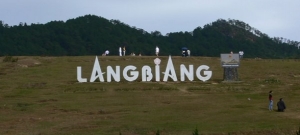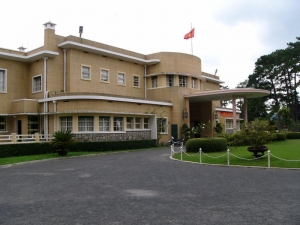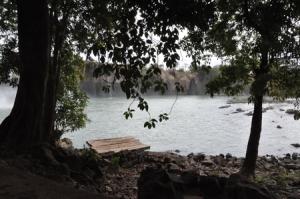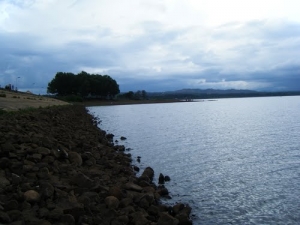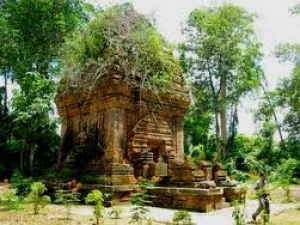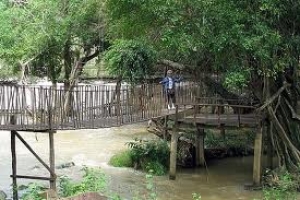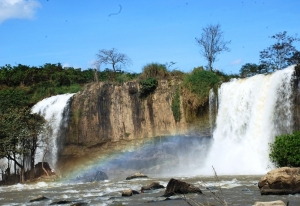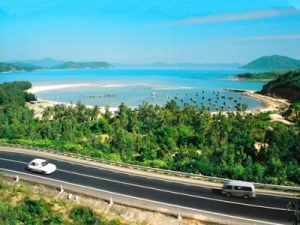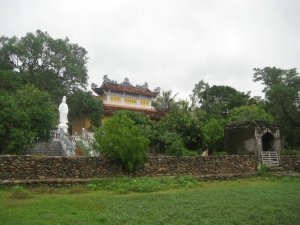
Asia Pacific Travel Team
Lang Biang Mountains- The Roof of Dalat City
As not far from the centre of Dalat, just about 12 km, tourists in Vietnam travel will see the Lang Biang Mountains standing high and beautiful as the roof of Dalat city, Lam Dong province. Legend has it that there was once a couple who were deeply in love with each other - the boy named K'lang and the girl named Ho Biang. However, there was a feud between the two tribes so they were not allowed to get married. At last, they overcame all the prejudice and got married. They moved onto a mountain to live.
Then Ho Biang was ill and K'lang tried in vain to save her. So he came back to the tribe to ask for help but the people in the tribe had shot him with a poisonous arrow. However, it was Ho Biang to be shot since she had shielded her husband. K'lang could not suffer such loss. He cried and his tear made up a big stream which is now called Dankia (the Golden Stream).
After their death, Ho Biang's father was too repentant of his mistake so he unified the tribes into one called K'ho. Since then, boys and girls in K'ho group are allowed to get married to each other. The mountain in La Ngu Thuong Village where the couple died is named Lang Biang. It is to memorize the couple with profound love.
Lang Biang Mountain is considered one of the highest mountains in Dalat. This area is typical for the tourism activities like camping, exploring the nature, and the culture of ethnic minority groups here. Lang Biang is also an ideal place for adventurous activities like mountain climbing, conquering high peaks. At the foot of the mountain lies a large valley which can be regarded to as an entertainment and ecological tourist site. Tourists can join in exciting programs like camp-fire, enjoying "Can wine" with ethnic minority people while listening to their cultural stories.
When hiking to Langbian Mountains, standing on its mount peak, tourists in Vietnam travel can see the Golden Stream and Silver Stream and have an overview of Dalat City. Dalat seems to be more fanciful when you observe it from Lang Biang mountain, like an aquarelle with two pieces of silk (the Golden and Silver Stream) prominently emerging among the limitless green forests and mountains.
Emperor Bao Dai's Summer Palace
Known as a very popular tourist attraction in Vietnam, Dalat, referred to as the city of love, gets a lot of tourists in Vietnam travel every year. There are many tourist attractions in Dalat and all these places are very popular among travelers coming here. And among them, the Emperor Bao Dai's Summer Palace is a must-visit place for all the visitors to Dalat.
Emperor Bao Dai had made three huge palaces in the city of Dalat. Among them the most visited palace is called the Dinh 3 which was built in 1933. The entire structure of the palace was made in art deco fashion. It was set inside a pine grove near the Pasteur Institute, in the southwestern direction of the lake. The décor has not changed in decades, except for the addition of Ho Chi Minh’s portrait over the fireplace. Inside this palace the visitors will come across a number of busts and sculptures which are of the deposed imperial family. There are many beautiful portraits as well inside the palace. The living quarters of the royal family are located upstairs. The room of Bao Long (Bao Dai’s eldest son), who now lives in France, is decorated in yellow, the royal color.

Garden of Emperor Bao Dai's Summer Palace- Dalat City- Lam Dong Province
The other two Emperor Bao Dai's Summer Palaces in Dalat remain open sporadically for the public. These two palaces are known as Dinh 1 and Dinh 2. They are mostly used for various government purposes. Out of the three palaces the most picturesque one is the Dinh 1 Palace.
If you are in Vietnam travel and in Dalat now, you should remember to visit the Emperor Bao Dai's Summer Palace.
The Sparkling of Dray Nur waterfall
The 30m falls, which are also known as Cai or Vo (wife), originate from the Krong Ana River. According to a ancient story, a long time ago, a man of Kuop Hamlet fell in love with a girl who lived on the other side of the Serepok River.
Their love remained hidden from their parents until they were inseparable. Unfortunately, they were in a sort of Romeo and Juliet situation, where the two families were old and bitter rivals. Naturally the parents did not approve, and all their efforts to stay together seemed destined to fail.
So one night, rather than being separated, the couple committed suicide in the Serepok River. Suddenly, there was a thunderstorm, water leaped up from the river and sounds came from the forest. The next morning, the people of the hamlet were surprised to see that the river had been separated in two, isolating the two families.
Ever since then the one river has been two: the Duc (husband) creates the Dray Sap Waterfall in Dak Nong Province, in the central highlands, while the Cai (wife) river feeds the Dray Nur waterfall in Dak Lak Province.
Water still flows down the falls in small streams, only to be united at the bottom. Many say that the sound it makes are echos of the delights and reproaches of that “star crossed love”.
These are some photos of the waterfall.
Don village, a mysterious legend
Don Village has the long-standing fame for elephant hunters and trainers. All Vietnamese children remember their heart a song about the elephants at this village.
Don Village is located northwest of Buon Ma Thuot in Krong Na Commune, Buon Don District, Dak Lak Province close to the Cambodian border, approximately 42km from Buon Ma Thuot. It is built on the Island inside Serepok Rive, home of many ethnic minority groups like: Ede, M’nong, G’rai, Lao, Thai, etc.
There is Yok Don National Park here - one of the most famous National Park in Vietnam.

It has been famous for its Kru -powerful elephant tribe leaders, for a long time, and is well known in India and France for its elephant. Y Pui, a 102-year-old man (1883-1985) who tamed over 450 elephants, spent part of his life as King Bao Dai’s Mahout. Elephant training and hunting has been passed down through generations. It takes 67 months to domesticate a wild elephant.
Elephant riding is a experience that toursits in Vietnam travel will never forget. Include fording across the Serepok River, which is pretty cool. The elephants can hold two to three people, depending on their girth (the passengers, not the elephants).
It's a pleasant enough spot - there's The raditional long house full of souvenirs to buy, and the tribespeople that work there spend the day putting on musical shows using traditional instruments for group after group of tourists.
There are an annual traditional festival of the Don Village, which will also show visitors performances of gongs, UNESCO’s oral and intangible heritage of humanity.
This is an opportunity for Vietnamese and foreign tourists to come and learn about the Don Village and York Don National Park of the Central Highlands province of Dak Lak. Don Village becomes the “can-not-be-missed” destination in Vietnam travel.
Ea Kao Lake Tourist Resort in Dak Lak Province
Far from 12km south of Buon Ma Thuot City, Ea Kao Lake is a famous tourist resort of Dak Lak Province. This tourist resort is built with a large and modern scale, but its traditional identities are still preserved.
The tourist resort of Ea Kao Lake covers an area of 120 hectares (not counting the surface of the lake) with various areas, including amusement parks, gardens, restaurants, natural reserve and guesthouses. This tourist resort is surrounded with numerous green trees, contributing to the maintenance and restoration of the province’s ecological environment, as well as to the preservation and promotion of cultural values of the ethnic groups in the region.
Coming to Ea Kao Lake, visitors in Vietnam travel will have opportunities to relax and enjoy fresh air, and take part in entertainment, tourist and cultural activities.

With a temperate climate, average temperature of 20.7ºC and annual average rainfall of 2,155 mm, this area creates favorable conditions for the development of the regional tourism in particular and for the development of Vietnam tourism in general.
Yang Prong Cham Tower in Central Highlands
Situated in Ea Sup District, 100km away from Buon Ma Thuot, Yang Prong is known as the only Cham Tower in Central Highlands (Tay Nguyen). It was built at the end of the 13th century to worship the God Siva or also called Mukhalinga – symbol of fecundity, to wish for a peaceful and happy life, multiplied -human race, and prosperity. Lying by the Ea H’Leo River, Yang Prong Tower is an architectural structure of red ceramic bricks resting on a foundation made of blue marble stones, with its top as a flower’s bud.
The tower is 9 meters high with a square-shaped base of 5 meters each side. Even though it looks like there are four entrances, in fact, the tower has only one door opened to the East, which is referred to as the kingdom of the Gods. The other three “doors” are located in the three other sides of the towers and they are all artificial. Unlike the designs of many other Cham towers in Middle Vietnam, the upper part of Yang Prong is expanded into a giant cone-shaped roof, from which visitors in Vietnam travel can freely stretch their view over the wondrous scenery of Central Highlands.
Yang Prong Cham Tower bears cultural features of Cham people. The tower proves the history of the wet-rice civilization on the highland. The Cham Tower in Dak Lak is special, but few people know about its presence here. On August 3rd, 1991 the Ministry of Culture and Information issued a decision recognizing Yang Prong Cham Tower as an ancient architectural site under the management of the government. Today, this tower has become an ideal place for travelers joining tours in Vietnam and exploring the special features of the Central Highlands’ culture.
When coming to Yang Prong Cham Tower, you will experience a unique and rare feeling of being in another world. Nowadays, this tower is one of the magnets of Vietnam Tourism, attracting a number of researchers and visitors in all over the world.
“The pearl of YokDon” or YokDon National Park
Whenever tourists joining tours in Vietnam travel to Dak Lak, they usually stop at Buon Don, a famous tourist attraction. Being proud of its bio-diversity and the largest national park in Vietnam, which attracts both tourists and scientists. YokDon national park covers 115,000ha, not including 10,000ha of its belt zone. Its jungles bear the characteristics of tropical forests in Southeast Asia. According to primary survey, YokDon boasts 464 species of flora, most of which are Michelia (ngoc lan). In dry seasons, it is still cool, just like the climate in Da Lat, and orchids are still in full bloom.

The most attractive thing for tourists in Vietnam travel to see in this park is its diverse kinds of forest. Nowhere else in Viet Nam preserves so many species of precious birds and animals as in YokDon National Park. This natural park is home to 62 animal species, 196 bird species, 46 reptile species, 15 fresh water fish species and thousands of insect species. Of the 56 precious animal species of Indochina, Yok Don National Park preserves 38, of which 17 are listed in the World Red Book. This park is the only place in Viet Nam where great numbers of precious animals are still preserved: elephants, wild bulls, gayals, sambar deer, peacocks, water varans, and so on.
When visiting YokDon National Park, tourists can ride on elephant's back to make a sightseeing tour in the forest, or to wade across Serepok River. They can enjoy traditional specialties or drink can alcohol together with the locals while listening to village patriarch's stories about legends of this land.
Now, if you have time to come to YokDon National Park, you will have a chance to discover fascinating things, which surely leave unforgettable impressions on your mind.
Buon Ma Thuot- the biggest city in Central Highlands
Buon Ma Thuot, with 536 m in height, is the capital of Dak Lak province and also the biggest city in Central Highlands. The city has a calm, cool weather during the year, with an average temperature of 23oC. In the language of the E-de ethnic people, Buon Ma Thuot (or Buon Ama Y Thuot) means the village of father Thuot, the man who built the first village on the bank of the Ea Tam Stream.
Buon Ma Thuot is also one of the largest towns of Central Highlands. It is famous for lush array of fruits, vegetables and especially coffee! Buon Ma Thuot coffee is proud of being ranked the first position in Vietnam market for a long time; and not surprisingly, it has not found any rival yet.
Tourists in Vietnam tourism can visit the spectacular waterfalls such as Dray Sap, Dray Anour, Dray H'ling, etc when coming to Buon Ma Thuot. The travelers can totally enjoy the trips to the villages of the E-de and M'nong ethnic groups to experience the essences of the Gong Festival, ride the elephant during a hunt in the mysterious forests, or simply sit still on a piragua and breath in the air of the Asian wilderness.
The center of Buon Ma Thuot city
Apart from the ancient constructions, most of which are carefully built wood houses, local people find it essential to build more modern and creative buildings. Thus, when tourists joining tours in Vietnam want to visit Buon Ma Thuot nowadays, they can see the wide roads decorated with green trees and beautiful flowers and a lot of newly constructed residential complexes. However, the most important thing to do in Buon Ma Thuot is nothing else but drinking coffee!
Dak Lak 's Basalt empowers the city to grow Robusta Coffee better than anywhere else in the world. Buon Ma Thuot Coffee has been mesmerizing consumers from both inside and outside the country for decades!
If you are traveling around Vietnam, you once time visit Buon Ma Thuot and don’t leave this city without having sampled the best coffee in the country.
Xuan Dai Bay- A Gift Endowed to Phu Yen by The Nature
Traveling about 45 kilometers to the north of Tuy Hoa city, tourists in Vietnam travel will stop at Xuan Dai Bay. The National Highway 1A runs along the western bank of Xuan Dai bay, to the North and to the South, on arriving at the top of Doc Gang slope, visitors can easily enjoy a partial view of Xuan Dai bay. Boats and ships can enter from the estuary of the bay or exit from the ports of Dan Phuoc, Tien Chau, etc make a sightseeing tour around the entire bay.
The surface area of the bay is about 13.000 acres. The estuary of the bay is about 4.4 kilometers wide, with the depth from 7 meters to 18 meters; the bank of the bay is about 50 kilometers long, running through various areas of different terrain with rather interesting names such as Ganh Den (light reef), Mui Da Ong (Laterite Cape), Ganh Den (Black reef), Ganh Do (Red reef), Vung Lam bay, Vung Mam bay, Vung Dong bay, Vung Su bay, Vung Chao bay, Vung Me bay, Vung La bay, Bai Om beach, Tu Nham beach, Dong Tranh cape, Ganh Tuong cape, Hon Mom islet, Tai Ma cape, Ganh Ba reef, Ong Xa islet, Nhat Tu Son island, Con Ca islet.
On the south-east side of the bay are Da Dia reef, Hon Lao Mai Nha islet; In the north are Tu Nham beach, Cu Mong lagoon, Vung Vuong bay, Bai Tram beach, Bai Nom beach, in the sea there are various coral reefs and sea-weeds.

The scenery of the sea, the mountains, the sky and the clouds of Xuan Dai bay together with the famous special foods here such as jumping oysters, perfume snails, shrimps, etc has been fascinating so many poets and tourists in Vietnam travel:
Xuan Dai bay surrounded by mountains and sea
The natural landscape recalled
The vestiges of the ancient God temple
And Tien Chau boat festival
The two rivers join into one with the tide up and down
With reefs of scattered rocks on three sides
Green sea-pines on white sand ground
The forest in the natural site
Xuan Dai bay has witnessed a lot of historic events: in the years of 1775 “ 1801, there was a sea-battle between the Tay Son army and the Nguyen Dynasty; during the World War II, the navy ship of the Japanese Royal Ship was sunk in the middle of Xuan Dai bay by the allied war-planes; Vung Lam bay used to be the most bustling trading port of Phu Yen in the past, the door connecting Phu Yen to the outer trading worlds.
Near Xuan Dai bay, there are famous landscapes such as Da Dia reef, O Loan lagoon, Cu Mong lagoon, etc, which are ideal places for organizing various types of tourism activities such as mountain climbing, sea-diving, boat-racing, wind-surfing and exploring the sea.
If you have never visited Phu Yen and come to Xuan Dai Bay before, now please come to Xuan Dai bay to explore and experience the gift endowed to Phu Yen by the nature.
Da Trang Pagoda in Phu Yen- A Historical Relic of The Nation
Da Trang pagoda is located on the slopes of Da Trang Mountain in An Dan Commune, Tuy An District, 20km north of Tuy Hoa City. The pagoda was built in 1797, under King Quang Toan of the Tay Son Dynasty. Today, it is one of the most well-known pagodas, attracting a large number of tourists in Vietnam travel to Phu Yen to visit.
Da Trang pagoda was founded by Buddhist monk Huy Phap Chuyen of the Lam Te faction and currently it is run by the tenth generation of Lam Te Buddhist monks.
 Facing the Cai River, it stands on an area approximately 100m high, which was once the capital of Phu Yen Province in the 17th century. There is a treacherous road paved with stepping-stones leading to the gate of the pagoda. The pagoda was honoured by the emperor in 1889, and burnt to a cinder in 1929. It was then rebuilt with funds raised by numerous Buddhists from provinces throughout central Vietnam. In 1988, the sanctum of the Da Trang Pagoda was restored.
Facing the Cai River, it stands on an area approximately 100m high, which was once the capital of Phu Yen Province in the 17th century. There is a treacherous road paved with stepping-stones leading to the gate of the pagoda. The pagoda was honoured by the emperor in 1889, and burnt to a cinder in 1929. It was then rebuilt with funds raised by numerous Buddhists from provinces throughout central Vietnam. In 1988, the sanctum of the Da Trang Pagoda was restored.
Behind the sanctum is a tower yard and a worshipping house for ancestors. The towers are carved with ornamental images, including the four sacred animals (dragon, unicorn, turtle, and phoenix). Surrounding the pagoda is an ancient green garden of mango trees. The Da Trang mango is a special product of Phu Yen known for its sweet smell and delicious taste.
The path leads to Da Trang pagoda
Please come to Phu Yen and pay a visit to Da Trang pagoda where you can see the historical relic of Tay Son Dynasty that still remains today.


